Wikipedia:Picture of the day/July 2023
|
Featured picture tools: |
These featured pictures, as scheduled below, appeared as the picture of the day (POTD) on the English Wikipedia's Main Page in July 2023. Individual sections for each day on this page can be linked to with the day number as the anchor name (e.g. [[Wikipedia:Picture of the day/July 2023#1]] for July 1).
You can add an automatically updating POTD template to your user page using {{Pic of the day}} (version with blurb) or {{POTD}} (version without blurb). For instructions on how to make custom POTD layouts, see Wikipedia:Picture of the day.Purge server cache
July 1

|
|
The Alcobaça Monastery is a Catholic monastic complex located in the town of Alcobaça, Portugal, 120 km north of Lisbon. It was established in 1153 by the first Portuguese king, Afonso Henriques, and developed a close association with the Portuguese monarchy throughout its history, leading it to become the richest and most influential monastery in Portugal. By 1300, it had a population of almost 1,000 monks and business interests including farming, fishing and trade. It closed in 1834, amid the dissolution of the monasteries in Portugal. Due to its artistic, cultural and historical relevance as one of Portugal's oldest Gothic buildings, the monastery and its church were included in UNESCO's World Heritage Site list in 1989. Photograph credit: Alvesgaspar
Recently featured:
|
July 2
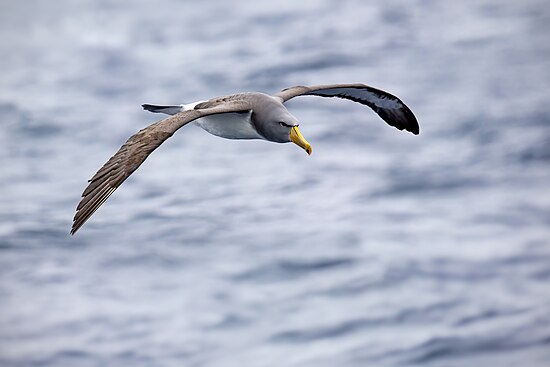
|
|
The Chatham albatross (Thalassarche eremita) is a medium-sized black-and-white albatross which breeds only on The Pyramid, a large rock stack in the Chatham Islands, New Zealand. It is sometimes treated as a subspecies of the shy albatross Thalassarche cauta. It is the smallest of the shy albatross group. Photograph credit: JJ Harrison
Recently featured:
|
July 3

|
K. K. Usha (3 July 1939 – 5 October 2020) was an Indian judge who served as the chief justice of the Kerala High Court between 2000 and 2001. The first female judge on the court, she advocated for women's rights and for the elimination of all forms of discrimination. After retiring from the court, she served as the president of the Excise and Service Tax Appellate Tribunal and then headed an Indian People's Tribunal enquiry in 2005 and 2006 into communal violence in Orissa. The enquiry was disrupted by activists from the Sangh Parivar. In 2011, she served as a member of an IPT panel on human rights issues in Manipur. This portrait photograph of Usha in court dress was taken in May 2020. Photograph credit: Augustus Binu
Recently featured:
|
July 4

|
|
The Large Hadron Collider (LHC) is the world's largest and highest-energy particle collider. It was built by the European Organization for Nuclear Research (CERN) between 1998 and 2008 in collaboration with more than 10,000 scientists and hundreds of universities and laboratories, as well as more than 100 countries. The LHC lies in a tunnel 27 kilometres (17 mi) in circumference and as deep as 175 metres (574 ft) beneath the France–Switzerland border near Geneva. On 4 July 2012, CERN announced the discovery of the Higgs boson at the LHC, after a 40-year search for its existence. This photograph shows the interior of a section of the LHC's tunnel (sector 3–4). The collider's dipole magnets are painted in blue to protect them from rust. Photograph credit: Maximilien Brice
Recently featured:
|
July 5
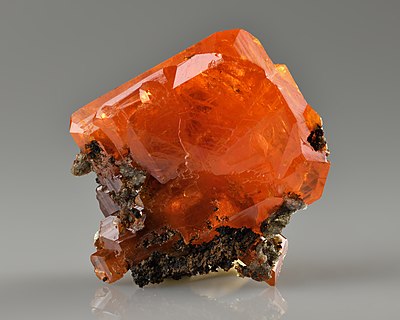
|
Wulfenite is a lead molybdate mineral with the chemical formula PbMoO4. It is most often found as thin tabular crystals with a bright orange-red to yellow-orange color, sometimes brown, although the color can be highly variable. In its yellow form it is sometimes called "yellow lead ore". The mineral was first described in 1845 for an occurrence in Bad Bleiberg, Austria, and was named after Franz Xaver von Wulfen, an Austrian mineralogist. This specimen of wulfenite, embedded in a small amount of matrix, measures 2.2 cm × 1.7 cm × 0.3 cm (0.87 in × 0.67 in × 0.12 in) in size and was extracted from the Red Cloud mine near Yuma, Arizona. Photograph credit: Ivar Leidus
Recently featured:
|
July 6

|
|
The Kowloon Walled City was a densely populated enclave of China within the boundaries of Kowloon City in Hong Kong. Built as an Imperial Chinese military fort, the walled city became a de jure enclave after the New Territories were leased to the United Kingdom in 1898. Its population increased dramatically after the end of the Japanese occupation of Hong Kong during World War II, attracting mostly refugees fleeing the renewed Chinese Civil War. The walled city was crossed by alleyways, often only 1 to 2 metres (3.3 to 6.6 ft) wide, with poor lighting and drainage. Construction went unregulated, and most of the roughly 350 buildings were built with poor foundations and few or no utilities. The population was estimated at 33,000 in 1987, giving the walled city a density of around 1,255,000 per square kilometre (3,250,000/sq mi), making it the densest location in the world at the time. The walled city was demolished between 1993 and 1994 and the site is now occupied by Kowloon Walled City Park. Photograph credit: Ian Lambot
Recently featured:
|
July 7

|
|
Raikoke is an uninhabited volcanic island belonging to Russia, one of the Kuril Islands located in the Sea of Okhotsk (part of the northwest Pacific Ocean), 16 kilometres (9.9 mi) from the island of Matua. This image of the island's volcano erupting in June 2019 was taken by a crew member of the Expedition 59 mission. Photograph credit: NASA Expedition 59
Recently featured:
|
July 8

|
Equisetum arvense, also known as the field horsetail or common horsetail, is a herbaceous perennial plant in the Equisetidae (horsetails) sub-class, native throughout the Arctic and temperate regions of the Northern Hemisphere. It has separate sterile non-reproductive and fertile spore-bearing stems growing from a perennial underground rhizomatous stem system. The fertile stems are produced in early spring and are non-photosynthetic, while the green sterile stems start to grow after the fertile stems have wilted and persist through the summer until the first autumn frosts. This fertile spore-bearing E. arvense stem was photographed in Keila, Estonia. Photograph credit: Ivar Leidus
Recently featured:
|
July 9

|
Pauline Kirby (July 9, 1905 – November 10, 1981) was a member of the United States Army Nurse Corps. She was born in Greenwood, Mississippi. She held several positions during her 30 years in the United States Army Nurse Corps and the Army of the United States, and was one of the first two Nurse Corps officers to serve in the temporary grade of Colonel. Photograph credit: United States Army; restored by Adam Cuerden
Recently featured:
|
July 10

|
|
The Battle of Edessa took place between the armies of the Roman Empire under the command of Emperor Valerian and the Sasanian Empire under Shahanshah (King of the Kings) Shapur I, Shapur I, on the site of the modern Turkish city of Urfa in 260. The Roman army was defeated and captured in its entirety by the Sasanian forces; for the first time, a Roman emperor was taken prisoner. This 3rd-century Sasanian rock-face relief, located at the ancient necropolis of Naqsh-e Rostam in modern-day Iran, depicts Shapur's triumph over Valerian in the battle. Sculpture credit: Sasanian Empire; photographed by Diego Delso
Recently featured:
|
July 11
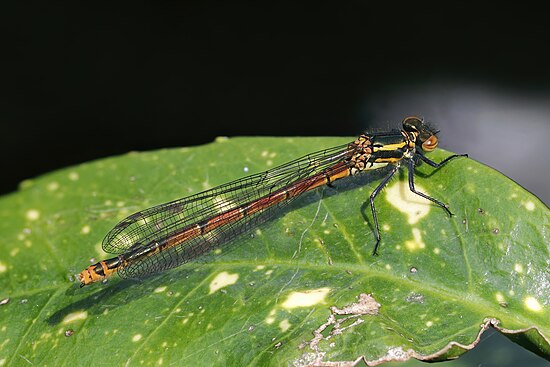
|
|
The large red damselfly (Pyrrhosoma nymphula) is a species of damselfly belonging to the family Coenagrionidae. Found mainly in Europe, with some populations also in northern Africa and western Asia, it inhabits small ponds, lakes and dikes, and occasionally slow-moving rivers. Large red damselflies have black legs and wing spots in both sexes, and can reach a body length of 33 to 36 millimetres (1.3 to 1.4 in). They are often the first damselflies to emerge in the spring, usually in April or May, and adults can be found until September in some localities. This female large red damselfly was photographed on Cumnor Hill in Oxfordshire, England. It is of the form fulvipes, one of three colour forms for the species. Photograph credit: Charles J. Sharp
Recently featured:
|
July 12
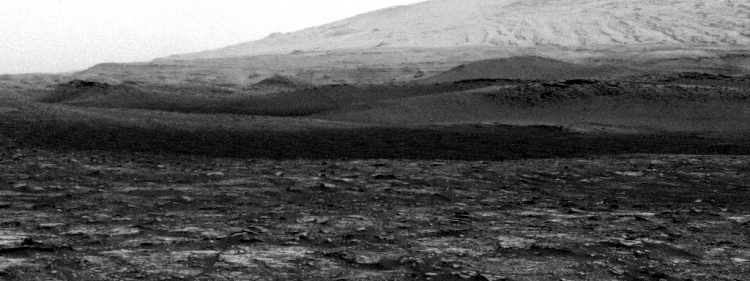
|
|
The atmosphere of Mars is a layer of gases surrounding Mars, which is composed primarily of carbon dioxide (95%), along with molecular nitrogen (2.8%), and argon (2%) and trace levels of other compounds. The Martian atmosphere is much thinner than Earth's, its average surface pressure of 610 pascals (0.088 psi) being less than 1% of the Earth's value. This prohibits the existence of liquid water on the surface of Mars, but many studies suggest that the Martian atmosphere was much thicker in the past. The effective temperature at the surface is around 210 K (−63 °C; −82 °F), and it has a large daily temperature range due to the low thermal inertia; in some regions it can vary from −75 °C (−103 °F) to near 0 °C (32 °F). Dust devils and dust storms are prevalent on Mars, which are sometimes observable by telescopes from Earth, and can threaten the operation of Mars rovers. Planet-encircling dust storms occur on average every 5.5 Earth years (3 Martian years), but the mechanism responsible for these storms is not well understood. This small dust devil was captured by NASA's Curiosity rover in 2020. Animation credit: NASA / JPL-Caltech / Space Studies Institute
Recently featured:
|
July 13

|
Simone Veil (née Jacob; 13 July 1927 – 30 June 2017) was a French magistrate and politician who served as Health Minister in several governments and was President of the European Parliament from 1979 to 1982, the first woman to hold that office. As health minister, she is best remembered for advancing women's rights in France, in particular for the 1975 law that legalized abortion in France, today known as Veil Act (French: Loi Veil). From 1998 to 2007, she was a member of the Constitutional Council, France’s highest legal authority. She is shown here receiving the Centennial Award at the first Four Freedoms Award ceremony in 1982. Photograph credit: Rob C. Croes, Anefo; restored by Adam Cuerden
Recently featured:
|
July 14
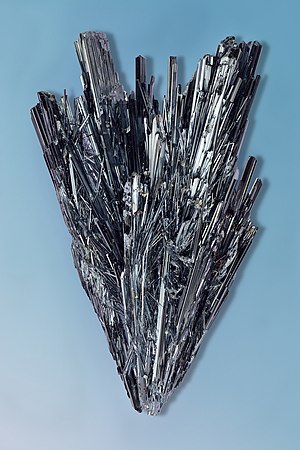
|
Stibnite, also known as antimonite, is a sulfide mineral with the formula Sb2S3. This soft grey material crystallizes in an orthorhombic space group. Pastes of stibnite powder in fat or other materials have been used since at least 3000 BC as eye cosmetics in the Mediterranean and farther afield; in this use, it is called kohl. It was used to darken the brows and lashes, or to draw a line around the perimeter of the eye. Stibnite is also the most important industrial source for the metalloid antimony. This stibnite crystal, measuring 5.0 cm × 2.8 cm × 1.5 cm (1.97 in × 1.10 in × 0.59 in), was found in the Herja Mine in Maramureș, Romania. Photograph credit: Ivar Leidus
Recently featured:
|
July 15
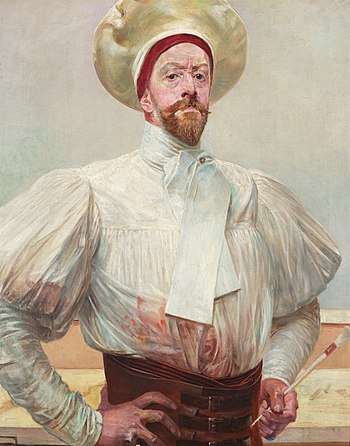
|
Jacek Malczewski (15 July 1854 – 8 October 1929) was a Polish Symbolist painter. One of the most revered painters of Poland, he was associated with the patriotic Young Poland movement following a century of partitions. Malczewski is regarded as the father of Polish symbolism, and his creative output combined the predominant style of his times with historical motifs of Polish martyrdom, the romantic ideals of independence, Christian and Greek mythology, folk tales, as well as his love of the natural world. Many of Malczewski's paintings prominently feature self-portraits in elaborate costume, including this 1914 oil-on-canvas painting, titled Self-Portrait in White Dress, which depicts him wearing a white traditional 19th-century artist's smock-frock, a white neckerchief (a common garment for European men in the 18th and 19th century), and a wide white beret. The portrait is in the collection of the National Museum in Kraków. Painting credit: Jacek Malczewski
Recently featured:
|
July 16

|
|
A snowflake is a single ice crystal that has achieved a sufficient size and may have amalgamated with others, and that falls through the Earth's atmosphere as snow. Each flake nucleates around a dust particle in supersaturated air masses by attracting supercooled cloud water droplets, which freeze and accrete in crystal form. Complex shapes emerge as the flake moves through differing temperature and humidity zones in the atmosphere, such that individual snowflakes differ in detail from one another, but may be categorized in eight broad classifications and at least eighty individual variants. The main constituent shapes for ice crystals, from which combinations may occur, are needle, column, plate, and rime. Snow appears white in color despite being made of clear ice. This is due to diffuse reflection of the whole spectrum of light by the small crystal facets of the snowflakes. This macro photograph of a relatively large snowflake, 4 to 5 mm (0.16 to 0.20 in) in width, was captured with a backlit glass background. Photograph credit: Alexey Kljatov
Recently featured:
|
July 17
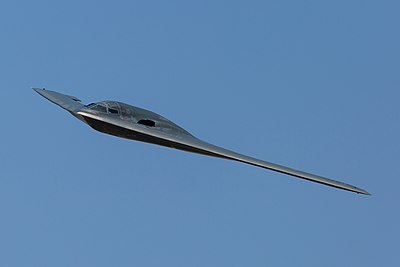
|
The Northrop Grumman B-2 Spirit is an American heavy strategic bomber featuring low-observable stealth technology designed to penetrate dense anti-aircraft defenses. A subsonic flying wing with a crew of two, the plane was designed by Northrop, later Northrop Grumman, and produced from 1987 to 2000. With the ability to drop both conventional and thermonuclear weapons, there are twenty B-2 Spirits in service with the United States Air Force, one having been destroyed in a 2008 crash at Andersen Air Force Base. This B-2 Spirit was photographed in flight at an air show at Dyess Air Force Base, Texas, in 2018. Photograph credit: Balon Greyjoy
Recently featured:
|
July 18
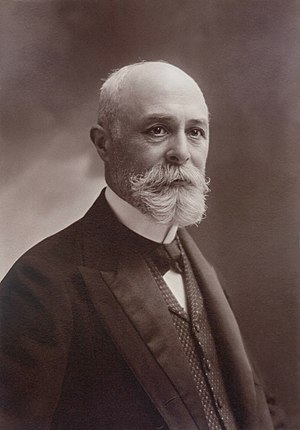
|
Henri Becquerel (1852–1908) was a French engineer and physicist who was the first person to discover evidence of radioactivity. Born in Paris into a family that also included the engineers Antoine César Becquerel, Edmond Becquerel and Jean Becquerel, he studied engineering at the École polytechnique and the École nationale des ponts et chaussées, going on to take up positions at the National Museum of Natural History and the French government's Department of Roads and Bridges, before being appointed as a professor at the École polytechnique. For his work in the field of radioactivity he received the 1903 Nobel Prize in Physics, alongside Marie Curie and Pierre Curie. The SI derived unit for radioactivity, the becquerel (Bq), is named after him. This portrait of Becquerel is an albumen paper print from a glass negative taken by Paul Nadar. Photograph credit: Paul Nadar; restored by Adam Cuerden
Recently featured:
|
July 19
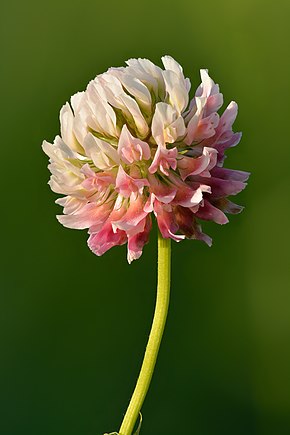
|
Trifolium hybridum, also known as the alsike clover, is a species of flowering plant in the pea family Fabaceae. The stalked, pale pink or whitish flower head grows from the leaf axils, and the trifoliate leaves are unmarked. The plant is up to 40 centimetres (1.3 ft) tall, and is found in fields and on roadsides – it is also grown as fodder (hay or silage). It blooms from spring to autumn. Originating in mainland Europe, it has become established as an introduced plant in the British Isles. This T. hybridum flower was photographed in Keila, Estonia. Photograph credit: Ivar Leidus
Recently featured:
|
July 20

|
Les Burgraves is a historical play by Victor Hugo, first performed by the Comédie-Française in 1843. It takes place along the Rhine and features the return of Emperor Barbarossa. The play failed commercially and was the last of Hugo's plays to be produced in his lifetime. The play is associated thematically with Hugo's Le Rhin, an essayistic book about the Rhine; both were inspired by a trip along the river he took with Juliette Drouet. This set design for act 2 of Les Burgraves was created by Charles-Antoine Cambon and Humanité René Philastre for the play's premiere. Set design credit: Charles-Antoine Cambon and Humanité René Philastre; restored by Adam Cuerden
Recently featured:
|
July 21

|
Jeanette Scissum is an American mathematician, space scientist, and diversity advocate. Born in Guntersville, Alabama, she gained bachelor's and master's degrees in mathematics at Alabama A&M University. After a brief teaching career, Scissum joined NASA's Marshall Space Flight Center in 1964, as an entry-level mathematician, the first African-American mathematician to be employed there. Her career achievements included techniques for improved forecasting of the sunspot cycle and leading activities in Marshall's Atmospheric, Magnetospheric, and Plasmas in Space project. After returning to Alabama A&M to complete a PhD, Scissum worked at the Goddard Space Flight Center as a computer systems analyst. This NASA photograph shows Scissum at her desk at Marshall Space Flight Center in the 1960s or 1970s. Photograph credit: NASA; restored by Adam Cuerden
Recently featured:
|
July 22

|
|
Lake Sherburne is located in the Many Glacier region of Glacier National Park, in the U.S. state of Montana. The lake is a reservoir, formed by Lake Sherburne Dam, which impounded Swiftcurrent Creek and was constructed between 1914 and 1921. Photograph credit: Jacob W. Frank, National Park Service
Recently featured:
|
July 23
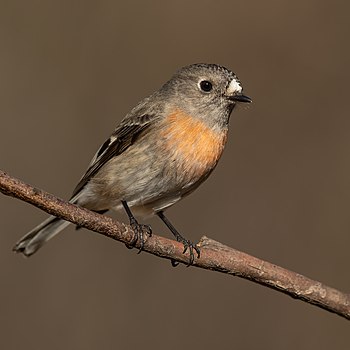
|
The scarlet robin (Petroica boodang) is a red-breasted passerine bird in the Petroicidae family (the Australasian robins). The species is found on continental Australia and its offshore islands, including Tasmania. With a length of 12 to 13.5 cm and a mass between 12 and 14 g, the male scarlet robin is black on the head, back and tail, and has a white belly and scarlet breast, with black and white wings. The female matches the male in pattern, but is duller, with brown plumage instead of black and a much more washed-out red on the breast. The scarlet robin feeds on arthropods, such as insects and spiders, adjusting its foraging behaviour seasonally – it feeds mostly on the ground during the winter, but during the summer and spring prey is more commonly snatched from bark and foliage. It is a territorial and monogamous species and defends its nesting territories both from others of the same species and from pairs of the related flame robin. This female scarlet robin was photographed in Blackheath, New South Wales, Australia. Photograph credit: JJ Harrison
Recently featured:
|
July 24

|
|
USS Commodore Perry was a 512-long-ton (520-tonne) steamer acquired by the Union Navy during the first year of the American Civil War. She was named after Commodore Oliver Hazard Perry, a naval officer who had commanded American forces on Lake Erie in the War of 1812. From January to February 1862, Commodore Perry was part of the North Atlantic Blockading Squadron, taking part in the attack, in cooperation with the Union Army, which resulted in the surrender of Roanoke Island by the Confederate States of America. She participated in several other campaigns through 1862, including the capture of Elizabeth City, North Carolina, and army–navy expeditions against Franklin, Virginia, and Hertford, North Carolina. From 1863 until the end of the war, she was engaged in patrols, both inland and in Virginia coastal waters. Commodore Perry was decommissioned and sold in 1865. This albumen silver print of Commodore Perry on the Pamunkey River was prepared from a glass negative taken by the Civil War photographer Timothy H. O'Sullivan. Photograph credit: Timothy H. O'Sullivan; restored by Adam Cuerden
Recently featured:
|
July 25
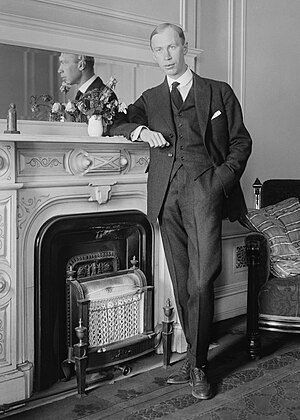
|
Sergei Prokofiev (1891–1953) was a Russian composer, pianist, and conductor. As the creator of works across numerous music genres, he is regarded as one of the major composers of the 20th century. His works include operas such as The Gambler, The Fiery Angel and The Love for Three Oranges; the suite Lieutenant Kijé; the ballet Romeo and Juliet; and Peter and the Wolf. Altogether during his adult life, he composed seven operas, seven symphonies, eight ballets, five piano concertos, two violin concertos, a cello concerto, a symphony-concerto for cello and orchestra, and nine completed piano sonatas. This photograph was taken circa 1918 in New York City. Photograph credit: Bain News Service; restored by MyCatIsAChonk
Recently featured:
|
July 26

|
Pyrite, or iron pyrite, is an iron sulfide with the chemical formula FeS2. It is the most abundant sulfide mineral. Pyrite's metallic luster and pale brass-yellow hue give it a superficial resemblance to gold, and the mineral is known informally as "fool's gold". The color has also led to the nicknames brass, brazzle, and Brazil, primarily used to refer to pyrite found in coal. Pyrite is usually found associated with other sulfides or oxides in quartz veins, sedimentary rock, and metamorphic rock, as well as in coal beds and as a replacement mineral in fossils, but has also been identified in the sclerites of scaly-foot gastropods. It has had various uses over time, including as an ignition for firearms, a source of sulfur dioxide and as jewellery. These cubic crystals of pyrite were found in the Huanzala mine in the Huallanca District of Peru. Photograph credit: Ivar Leidus
Recently featured:
|
July 27
|
The bombing of Hamburg in World War II by the Allies included numerous attacks on German civilians and civic infrastructure. As a large city and industrial centre, Hamburg's shipyards, U-boat pens and oil refineries were attacked throughout the war. In late July 1943, as part of a campaign of strategic bombing, the Allies launched Operation Gomorrah, an eight-day bombing campaign in Hamburg. In particular, during the 27/28 July raid carried out by the Royal Air Force (RAF), concentrated bombing created one of the largest firestorms of the war. Operation Gomorrah killed more than 37,000 people and destroyed 60% of the city's houses. An unexpected consequence of the raid was the reallocation of some German resources away from the fighting fronts. Large numbers of anti-aircraft guns and fighter aircraft were redeployed back to Germany, so aiding the Allies in their conduct of the ground war. This United States propaganda newsreel (above), released in August 1943, covers the Eighth Air Force's bombing of Hamburg during Operation Gomorrah. The newsreel's narrator states that Hamburg is "Germany's principal seaport and number-one war center" and that the bombing caused "devastation of war plants", but does not mention the deliberate destruction of entire residential neighborhoods. The intent was to reduce German industrial production for the war effort by making workers homeless – an opinion based on study of the effect on British factories of German bombing during the Blitz. This aerial photograph (below), taken by an RAF officer, shows part of the Hamburg district of Eilbek after this dehousing campaign; it was probably taken after the end of the war and certainly after rubble and other debris had been cleared.
Recently featured:
|
July 28

|
The Bubble Nebula, formally known as NGC 7635, is an H II region and emission nebula in the constellation Cassiopeia. It lies close to the direction of the open cluster Messier 52. The "bubble" is created by the stellar wind from a massive magnitude-8.7 young central star, BD+60°2522 (visible in the centre left of this image). The nebula is near a giant molecular cloud that contains the bubble's expansion while itself being excited by the hot central star, causing it to glow. It was discovered in 1787 by William Herschel. This photograph of the Bubble Nebula was taken by the Hubble Space Telescope in 2016. The image is a composite of separate exposures acquired by the telescope's Wide Field Camera 3; the colours are a result of assigning different hues (blue, green and red) to each monochromatic image associated with an individual filter used to sample a particular wavelength of light. Photograph credit: NASA, ESA, Hubble Heritage Team
Recently featured:
|
July 29
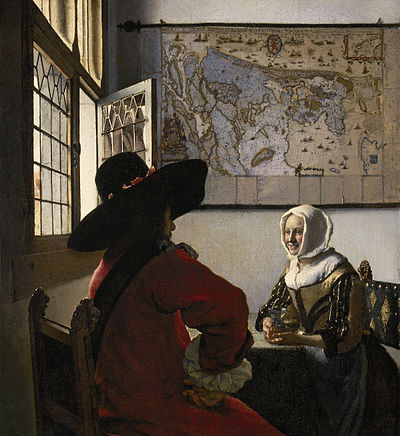
|
Officer and Laughing Girl is an oil-on-canvas painting by the Dutch artist Johannes Vermeer, produced around 1657. Created during the Dutch Golden Age, the painting has dimensions of 50.5 by 46.0 centimetres (19.9 in × 18.1 in). The main subject is a woman in a yellow dress, light is coming from the left-hand side of the painting from an open window, and there is a large map on the wall. Each of these elements occur in some of his other paintings, although this painting differs slightly with the man also sitting at the table. Art historians, who have suggested conflicting interpretations of the work, believe that a painting by Gerard van Honthorst inspired the composition and that Vermeer used a camera obscura to create the perspective. The work is now part of the Frick Collection in New York. Painting credit: Johannes Vermeer
Recently featured:
|
July 30

|
Geoffroy's tamarin (Saguinus geoffroyi) is a species of tamarin, one of the New World monkeys, found in Panama and Colombia. It is predominantly black and white, with a reddish nape. Diurnal, the species spends most of its time in trees, but comes down to the ground occasionally. It lives in groups that most often number between three and five individuals, and generally include one or more adults of each sex. It eats a variety of foods, including insects, exudates, fruits and other plant parts. Insects and fruits account for the majority of its diet, but exudates are also important. Since its teeth are not adapted for gouging trees to get to the sap, it can only eat exudates when they are easily available. This Geoffroy's tamarin was photographed at Gatun Lake, Panama. Photograph credit: Charles J. Sharp
Recently featured:
|
July 31
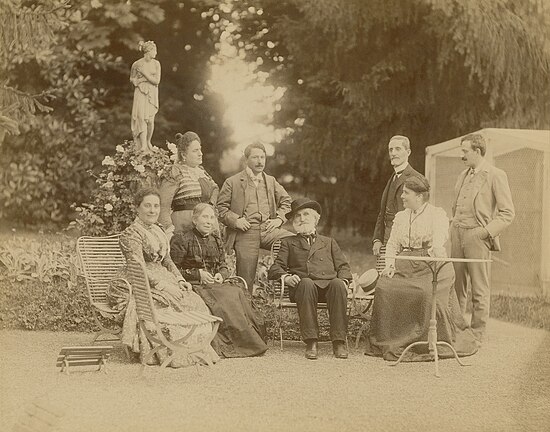
|
|
Giuseppe Verdi (1813–1901) was an Italian composer best known for his operas. He was born near Busseto to a provincial family of moderate means, receiving a musical education with the help of a local patron. Verdi came to dominate the Italian opera scene after the era of Gioachino Rossini, Vincenzo Bellini, and Gaetano Donizetti, whose works significantly influenced him. This group portrait, taken at Villa Verdi, his residence in Sant'Agata near Busseto in 1900, shows Verdi (seated in the middle) with various family and friends. His companion Teresa Stolz stands at the left, Giulio Ricordi is second from the right, and Verdi's adopted daughter, Maria Carrara, is seated at the far left. Also in the photograph is the painter Leopoldo Metlicovitz, standing on the far right. Photograph credit: Giulio Rossi; restored by Adam Cuerden
Recently featured:
|
Picture of the day archives and future dates

